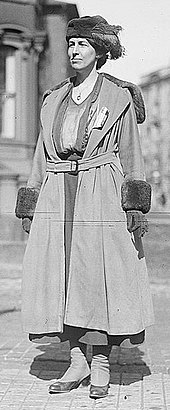Nora Stanton Blatch Barney
Nora Stanton Blatch Barney (born September 30, 1883 in Basingstoke , † January 18, 1971 in Greenwich , Connecticut ) was an American civil engineer , architect and suffragette .
Life
Nora Stanton Blatch was the daughter of William Blatch and Harriot Eaton Stanton Blatch (1856-1940) and granddaughter of Elizabeth Cady Stanton , both of whom were at the forefront of the women's movement in the United States. In the 1890s the family moved from England to New York . Blatch began studying at Cornell University in 1901, and in 1905 became the first woman in the United States to graduate with a degree in civil engineering. In the same year she was inducted into the American Society of Civil Engineers as the first woman . She worked first for the American Bridge Company , then for the New York City Board of Water Supply.
She also studied mathematics and electrical engineering at Columbia University and began working as an assistant to the inventor and broadcasting pioneer Lee De Forest , whom she married in 1908. They lived together in New Jersey , where Blatch worked for De Forest's company. In 1909 their daughter Harriot Stanton De Forest was born. In the same year, the couple separated, among other things because De Forest did not agree that his wife wanted to continue working after the birth of their child. Blatch returned to New York and worked for the Radley Steel Construction Company and the New York Public Service Commission .
In 1912 she divorced Lee De Forest. In 1914 she began working as an architect on Long Island , where she became known as a designer of numerous buildings. In 1919 she married the marine engineer Morgan Barney. Their second daughter, Rhoda, was born in 1920, their son John in 1922. In 1935 they moved to Greenwich, Connecticut , where Nora Stanton Blatch Barney also worked as an architect. She also planned the house for her own family, in which she would live for the rest of her life.
Political commitment
Nora Stanton Blatch Barney's mother and grandmother were active suffragettes. Her grandmother, Elizabeth Cady Stanton , co-founded the National American Woman Suffrage Association . Nora Stanton Blatch Barney campaigned for women's suffrage all her life . At the university she founded a women's rights organization. She later became the editor of Women's Political World magazine for the Women's Political Union . Like her mother, she was a member of the National Woman's Party , which campaigned for equal rights for women . Since the beginning of the Second World War , Nora Stanton Blatch Barney has also emerged as a peace activist. In her work "World Peace Through a Peoples Parliament" she took the view that a world government (with equal representation of men and women) must ensure international peace. From 1952 she actively campaigned for a ceasefire in the Korean War . In 1950, Nora Stanton Blatch Barney had to face an investigation by the Committee on Un-American Activities , but she dismissed the allegations with the note that all of her activities should serve the good of America.
Publications
- World Peace Through a Peoples Parliament: A Second House in World Government , self published, 1944
- Women as Human Beings , Greenwich, Conn., Self published 1946
- Life Sketch of Elisabeth Cady Staton , Self published, 1948
literature
- Sarah Allaback: The First American Women Architects . University of Illinois Press, Urbana 2008, ISBN 978-0-252-03321-6 , pp. 44-45.
- Barbara Sicherman , Carol Hurd Green: Notable American women. The modern period. A biographical dictionary, Volume 4 , Harvard University Press, Cambridge (Massachusetts) 1980, ISBN 0-674-62732-6 , pp. 53-55.
Web links
- Nora Stanton Blatch Barney in the Encyclopædia Britannica
- Nora Stanton Blatch Barney in the Global History Network of the Institute of Electrical and Electronics Engineers
| personal data | |
|---|---|
| SURNAME | Blatch Barney, Nora Stanton |
| ALTERNATIVE NAMES | Blatch, Nora Stanton (maiden name); Blatch Barney, Nora |
| SHORT DESCRIPTION | American civil engineer, architect and suffragette |
| DATE OF BIRTH | September 30, 1883 |
| PLACE OF BIRTH | Basingstoke , Hampshire , England |
| DATE OF DEATH | 18th January 1971 |
| Place of death | Greenwich (Connecticut) |
